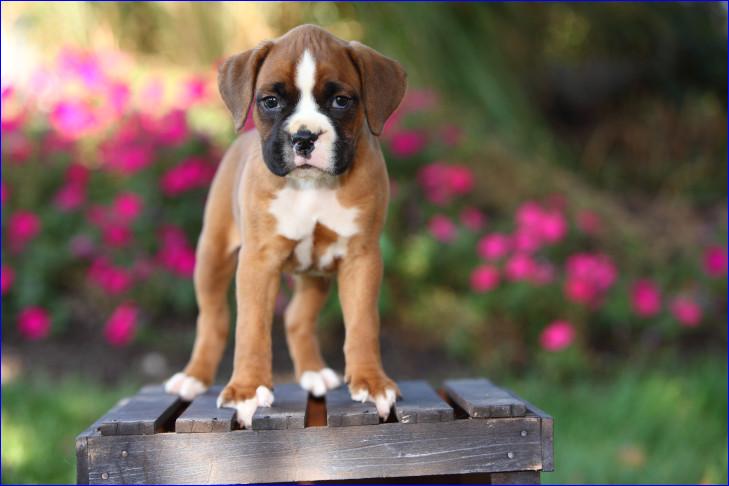


A perennial favorite, often placing in the top 10 most popular breeds, the fawn or brindle Boxer is a wiggly, kissy-faced friend. It's hard to imagine that the Boxer's ancestors were once war dogs of the Assyrian empire around 2,500 B.C.
The Boxer's Background
The Assyrian kingdom in northern Mesopotamia (present-day Iraq) bred large, powerful Tibetan dogs with wide, short muzzles, thick skin around the neck, and protruding lower jaws. Called "Molossers," after the city of Molossus in Ancient Greece, soldiers used the dogs to alert them of approaching enemies and to attack animals and men in battle.
These Molossers accompanied traders and migrating Assyrians to Egypt and Europe, where the dogs' popularity spread. Breeding for different purposes produced different types of Molossers.
In England, Molosser descendants helped create the modern Mastiff. Molosser descendants produced the Bullenbeisser, or "bull biter," in Germany. In medieval times, German noblemen used the Bullenbeisser as a hunting dog to run after, catch, and hold bear, bison, and wild boar. The dog's undershot bite, where the lower jaw protrudes beyond the upper jaw, enabled it to breathe while hanging on to the prey until the hunter arrived.
"With its undershot bite and nose slightly turned up, the Bullenbeisser would grab the bull's nose and 'bait' or hold the animal by its nose," says Bridget Brown, an AKC judge and President of the American Boxer Club. "The upturned nose helped the dog breathe and isn't supposed to be straight or flat."
When the German noble estates were divided during and after the Napoleonic Wars, the large Bullenbeissers were no longer needed. They became helpers for butchers and cattle dealers.
The hunters bred their large Bullenbeissers to smaller, Mastiff-type dogs from England, and the smaller Bullenbeissers became family and guard dogs. The Bullenbeisser was also bred to Wolfhounds and Deerhounds to create a large hunting dog known today as the Great Dane.
From natural selection, a smaller Bullenbeisser was bred from the larger one to produce the Boxer and the Bulldog. Rather than attack game head-on like most dogs, these dogs approached from the back. Using their powerful jaws, the Boxer and Bulldog held on to game until the hunter arrived.
The Modern Boxer in Germany
The smaller Bullenbeisser, ancestors of the modern Boxer, was developed in northeastern Belgium. In the late 1800s, the Boxer began developing as a breed in Munich, Germany. The first Boxer club was formed in Munich in 1895, with a dog show for Saint Bernards the following year. A good portion of the first breed standard remains in today's Boxer breed standard.
The modern Boxer began in the late 19th century in Germany when "Alt's Flora," a brindle bitch, was imported to Germany from France by George Alt and bred to a local Boxer. "Alt's Schecken" became the dam of the first registered Boxer, "Muhlbauer's Flock," two generations later in 1904.
Boxers in the United States
Boxers came to the United States in 1904 and the AKC registered the first Boxer that year. Over the next 30 years, 71 Boxers were on record, but that number increased to 724 by 1938. The breed quickly became a favorite as a show dog and a family companion.
The American Boxer Club's first year of operation was 1935. One of its first acts was establishing the Boxer as a member of the Working Group. In September 1939, World War II prevented Boxers from entering the U.S. from Europe.
In 1904, the Boxer was one of the first breeds selected in Germany for police training. During World War II, several breeds, including Boxers, German Shepherd Dogs, Doberman Pinschers, and Belgian Malinois, served in all branches of the armed forces. A famous photo depicts a Boxer parachuting behind enemy lines in Europe.
Boxers have fulfilled many roles as cattle dogs, police dogs, and war dogs in both world wars. They've also functioned as watchdogs, protection dogs, and guide dogs. When a male Boxer named "CH Bang Away of Sirrah Crest" won Best in Show at the Westminster Kennel Club Dog Show in 1951, the dog became a national celebrity. He appeared on the covers of many national magazines, including Vanity Fair, Life, Esquire, Sports Illustrated, and Time. The dog went on to win 121 Best in Show awards.
In 2020, a flashy fawn female GCHP2 CinniBon's Bedrock Bombshell "Wilma" became the top-winning Boxer in breed history when she surpassed Bang Away's Best in Show record and won her 133rd Best in Show.
Life With Boxers
In addition to conformation, Boxers excel in every dog sport. Highly energetic, Boxers thrive on activity but crave human affection and companionship.
"They want to be around you more than anything," Brown says. When Brown married her husband, Jack, in 1972, the couple bought their first Boxer a year later. "Jack wanted a snake, a guinea pig, and a Boxer," Brown says. "I agreed to a Boxer, and Jack showed her before we bred her. She whelped 11 puppies, and we were into Boxers."
The Browns discovered their Boxers were terrific with children, and the dogs had fun, goofy personalities.
"Ours were boisterous, goofy clowns that took four to five years to mature," Brown says. "My heart Boxer was 'Vinny,' GCH CH Raineylane Studio Diving SOMG who went on to produce 17 champions."

or register to post a comment.